Mayi Plus
The Feed the Future Haiti – Mayi Plus project seeks to improve the quality of maize seed supply, test new varieties for local adaptation and support the development of the maize seed industry in Haiti.
As staple foods, maize and wheat provide vital nutrients and health benefits, making up close to two-thirds of the world’s food energy intake, and contributing 55 to 70 percent of the total calories in the diets of people living in developing countries, according to the U.N. Food and Agriculture Organization. CIMMYT scientists tackle food insecurity through improved nutrient-rich, high-yielding varieties and sustainable agronomic practices, ensuring that those who most depend on agriculture have enough to make a living and feed their families. The U.N. projects that the global population will increase to more than 9 billion people by 2050, which means that the successes and failures of wheat and maize farmers will continue to have a crucial impact on food security. Findings by the Intergovernmental Panel on Climate Change, which show heat waves could occur more often and mean global surface temperatures could rise by up to 5 degrees Celsius throughout the century, indicate that increasing yield alone will be insufficient to meet future demand for food.
Achieving widespread food and nutritional security for the world’s poorest people is more complex than simply boosting production. Biofortification of maize and wheat helps increase the vitamins and minerals in these key crops. CIMMYT helps families grow and eat provitamin A enriched maize, zinc-enhanced maize and wheat varieties, and quality protein maize. CIMMYT also works on improving food health and safety, by reducing mycotoxin levels in the global food chain. Mycotoxins are produced by fungi that colonize in food crops, and cause health problems or even death in humans or animals. Worldwide, CIMMYT helps train food processors to reduce fungal contamination in maize, and promotes affordable technologies and training to detect mycotoxins and reduce exposure.
The Feed the Future Haiti – Mayi Plus project seeks to improve the quality of maize seed supply, test new varieties for local adaptation and support the development of the maize seed industry in Haiti.
The Heat Stress Tolerant Maize (HTMA) for Asia project is a public-private alliance that targets resource-poor people and smallholder farmers in South Asia who face weather extremes and climate-change effects. HTMA aims to create stable income and food security for resource-poor maize farmers in South Asia through development and deployment of heat-resilient maize hybrids.
South Asian farmlands have been increasingly experiencing climate change-related weather extremes. If current trends persist until 2050, major crop yields and the food production capacity of South Asia will decrease significantly – by 17 percent for maize – due to climate change-induced heat and water stress.
In response, CIMMYT and partners are developing heat stress-resilient maize for Asia. The project leverages the germplasm base and technical expertise of CIMMYT in breeding for abiotic stress tolerance, coupled with the research capacity and expertise of partners.
This project will lead to the identification of genes of interest to help guide breeding efforts to boost yield stability and resilience in low fertility agriculture systems subject to drought.
Smallholder maize farmers in marginal environments in Asia are prone to drought due to either scanty/erratic rainfall or falling groundwater levels.
The Affordable, Accessible, Asian (AAA) Drought Tolerant Maize Project is a partnership among CIMMYT, the Syngenta Foundation for Sustainable Agriculture, national agricultural research systems of Indonesia, Philippines and Vietnam to develop drought-tolerant maize for smallholder farmers in Asia.
AAA combines complementary technologies and comparative advantages, such as CIMMYT’s global expertise in drought-tolerant maize breeding, Syngenta’s elite germplasm bred for Asia, the national partners’ local knowledge of farmers’ requirements and their germplasm testing network.
This project covers a gamut of upstream and downstream activities: marker discovery (genome-wide association studies); trait discovery (understanding root structure and function-lysimetrics); marker applications (genomic selection); drought phenotyping facilities (rhizotronics, rain-out shelters; managed drought stress screening locations); germplasm development; hybrid deployment; and linking with potential hybrid commercialization partners.
Objectives
Funding Institutions
Principal Coordinator
Bindiganavile Sampath Vivek
The Drought Tolerant Maize for Africa Seed Scaling (DTMASS) project was officially launched in 2014 with the aim to meet demand and improve access to good-quality maize through production and deployment of affordable and improved drought-tolerant, stress-resilient and high-yielding maize varieties for smallholder farmers.
Led by CIMMYT and implemented through in-country public and private partnerships, DTMASS emphasizes scaling up and scaling out of drought tolerant maize seed, and uptake of the same among smallholder farmers. Over its lifespan, the project aims to produce close to 12,000 metric tons of certified seed for use by approximately 400,000 households, or 2.5 million people, in six countries in eastern and southern Africa.
DTMASS target countries (Ethiopia, Kenya, Mozambique, Tanzania, Uganda and Zambia) account for 25 percent, or 252 million, of the people in sub-Saharan Africa, and 41 percent of the maize production areas. DTMASS builds on the progress made by Drought Tolerant Maize for Africa and other complementary CIMMYT maize projects in Africa, including Improved Maize for African Soils and Water Efficient Maize for Africa.
Climate Resilient Maize for Asia is supported by Germany’s development agency GIZ, and implemented as a public-private partnership, which targets enhanced resilience among resource-poor, maize-based farming families in South and Southeast Asia by providing them with abiotic stress-tolerant maize hybrids adapted to rain-fed stress-prone production systems for crop diversification, intensification and higher yields.
Most of the maize in Asia is grown as a rain-fed crop, which is prone to vagaries of seasonal monsoon rains. This is clearly reflected in the productivity of maize under rain-fed systems — usually less than half of the irrigated system. The erratic distribution pattern of monsoon rains results in drought or water logging at different crop growth stages, which is the main factor responsible for relatively low productivity of rain-fed maize. Due to the possibility of uncertain economic returns, farmers often hesitate to invest in improved seed, fertilizers and inputs, which further add to poor yields of rain-fed maize. Climate change effects are further threatening an already challenging maize mega-environment in the Asian tropics, which are identified as subject to climate change effects, with high vulnerability and low adoption capacity.
The project deals with high priorities of Asian stakeholders related to improving maize production in the face of current and anticipated effects of climate change and access to diverse and valuable maize germplasm, building upon the GIZ-funded project known as “Abiotic stress tolerant maize for increasing income and food security among the poor in South and Southeast Asia,” where significant progress is being made towards understanding the rain-fed stress-prone agro-ecologies in South and Southeast Asia, development of improved maize germplasm with enhanced levels of tolerance to drought, waterlogging or combined stress tolerance.
The Agricultural Innovation Program (AIP) for Pakistan is working to sustainably increase agricultural productivity and incomes in the agricultural sector through the promotion and dissemination of modern technologies/practices in the livestock, horticulture (fruits and vegetables) and cereals (wheat, maize and rice) sector. The CIMMYT-led project aims to foster emergence of a dynamic, responsive, and competitive system of science and innovation in Pakistan.
This unique project places particular emphasis on building partnerships between public research and those it serves, including farmers and the private sector. AIP operates through three activity windows: commissioned projects, a competitive grants system and human resource development. Within these activity windows AIP addresses complex agricultural systems, but is divided into four “science windows’” including cereals and cereal systems, livestock, vegetables and perennial horticulture. The key indicator of AIP’s success is the number of small farmers who adopt or benefit from productivity or value-enhancing technologies.
The long term goals of the project are food security, environmental protection, gender sensitization and poverty reduction through the adoption of sustainable technologies, resource management practices, advance agricultural models and improved systems.
Building resilience, self-reliance and a reliable business model
The Buena Milpa project in Guatemala, conducted in collaboration with the country’s Agricultural Science and Technology Institute (ICTA), is aimed at implementing a sustainable intensification strategy for agriculture while reducing poverty, malnutrition and environmental damage.
The project, managed in collaboration with the U.S. Agency for International Development’s Feed the Future program, is based in the highlands of Guatemala, a region recognized for its diversity of maize varieties, flora and fauna. Farmers grow a wide variety of crops, including beans, legumes, pumpkin, fruit trees and native plants.
Through Buena Milpa, CIMMYT’s Sustainable Intensification Strategy for Latin America, with its focus on biodiversity conservation, participative breeding, soil conservation, farm diversification and maize, helps to conserve maize landraces and other important plants in the region.
Guatemala, where maize is a key food staple, is known for its wide maize biodiversity. The maize fields of most highland farmers are part of farm systems which includes animal husbandry (chickens, sheep or cattle). These complex farm systems diversify diets diet and sources of family income.
A range of soil conservation methods popular with farmers help preserve biodiversity. A variety of grasses, trees and other plants are used to ensure soil and field conservation.
Most of the maize in the region is grown on steep hillsides. Farmers have very little land and use as much of it as possible for crop production. Water and soil conservation practices aim to reduce the propensity to landslides, decrease erosion through soil cover, minimize the effects of erosion and help to settle the materials and soils mobilized through erosion.
The Buena Milpa project improves native maize landraces, increases productivity, improves plant architecture, grain and seed quality, thereby mitigating losses due to the effects of climate change and decreasing maize reserves, especially during periods of seasonal hunger.
Most farmers involved in the project belong to a Mayan ethnic group that has historically been marginalized and excluded from development processes. A social inclusion strategy fosters the participation of indigenous people, women, children, the young and the elderly in order to benefit everyone involved in maize production systems.
Links with other actors foster activities to generate information that raises awareness about how people are socially excluded, to inform and sensitize local actors about social dynamics that limit inclusion.
Intensive cereal cropping systems that include rice, wheat and/or maize are widespread throughout South Asia. These systems constitute the main economic activity in many rural areas and provide staple food for millions of people. The decrease in the rate of growth of cereal production, for both grain and residue, in South Asia is therefore of great concern. Simultaneously, issues of resource degradation, declining labor availability and climate variability pose steep challenges for achieving the goals of improving food security and rural livelihoods.
The Cereal Systems Initiative for South Asia (CSISA) was established in 2009 to promote durable change at scale in South Asia’s cereal-based cropping systems.
The project’s aim is to enhance the productivity of cereal-based cropping systems, increase farm incomes and reduce the environmental footprint of production through sustainable intensification technologies and management practices.
Operating in rural “innovation hubs” in Bangladesh, India and Nepal, CSISA complements regional and national efforts and involves public, civil society and private sector partners in the development and dissemination of improved cropping systems, resource-conserving management technologies, policies and markets. CSISA supports women farmers by ensuring their access and exposure to modern and improved technological innovations, knowledge and entrepreneurial skills that can help them become informed and recognized decision makers in agriculture.
The project is led by CIMMYT with partners the International Rice Research Institute and the International Food Policy Research Institute and funded by the U.S. Agency for International Development and the Bill & Melinda Gates Foundation.
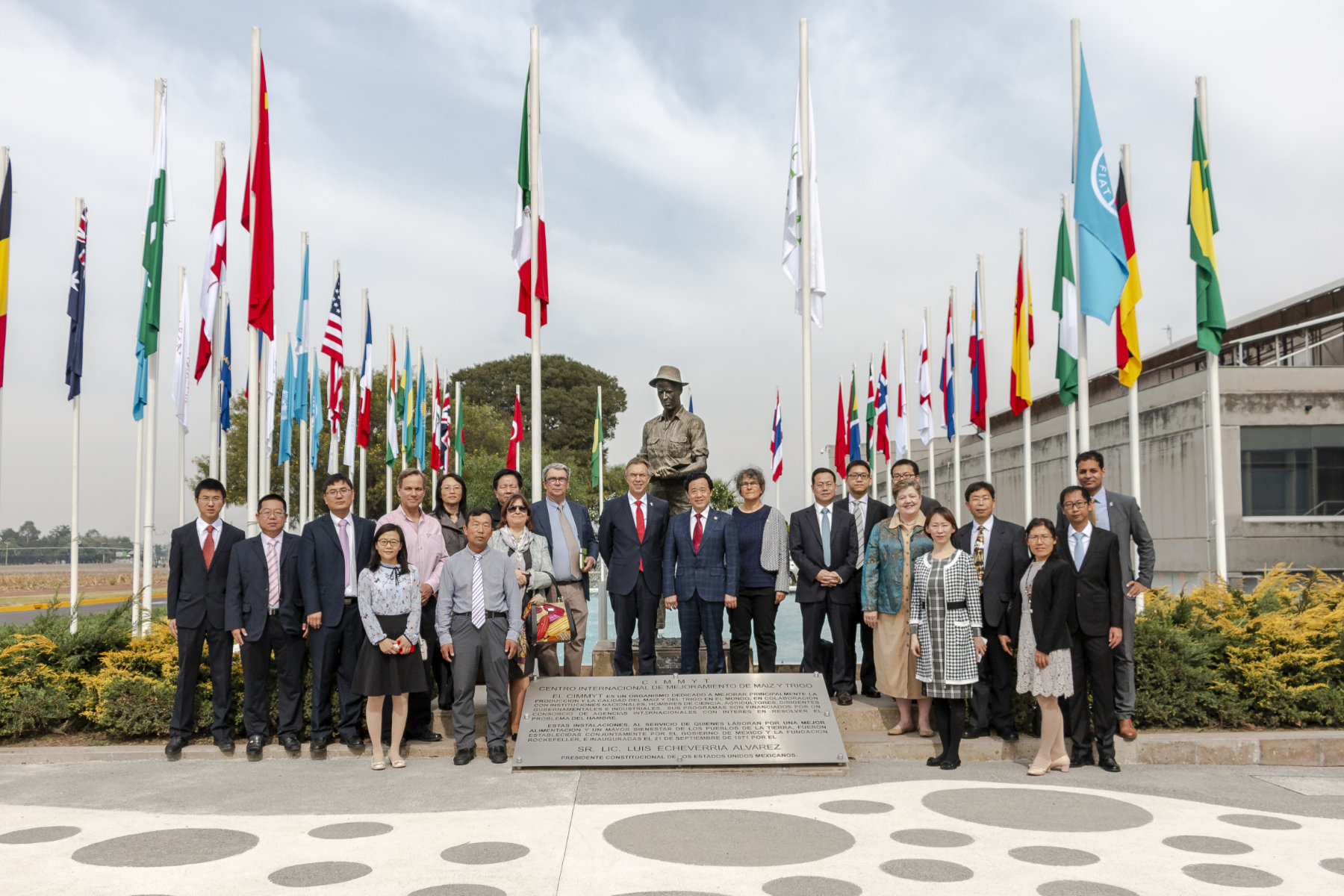
Qu Dongyu, China’s Vice Minister of Agriculture and Rural Affairs, and candidate for the position of Director-General of the Food and Agriculture Organization of the United Nations (FAO), visited the global headquarters of the International Maize and Wheat Improvement Center (CIMMYT) in Mexico on March 16, 2019. He had already visited CIMMYT in 2006.
Vice minister Qu was greeted by students and CIMMYT scientists from China, the director general, the deputy director general and members of the management team. Qu and his delegation learned about CIMMYT’s latest initiatives and toured the campus.
CIMMYT’s director general Martin Kropff explained the organization’s strategic focus on agri-food systems: “Our mandate is on maize and wheat but we think broadly. Our researchers use a systems approach and work on using these two crops to improve peoples’ livelihoods, which is our ultimate goal.”
Qu expressed his career-long efforts for integrating multi-disciplinary approaches to tackle global challenges and said that he was “happy to see CIMMYT combining breeding — for which CIMMYT is famous — with value-added approaches to bring together science, farmers and industry.”
With innovation and the end user playing key roles in the vice minister’s agenda, Qu enjoyed learning about the Excellence in Breeding Platform’s target product profiles work and two-way communication channels from innovation hubs in Mexico.
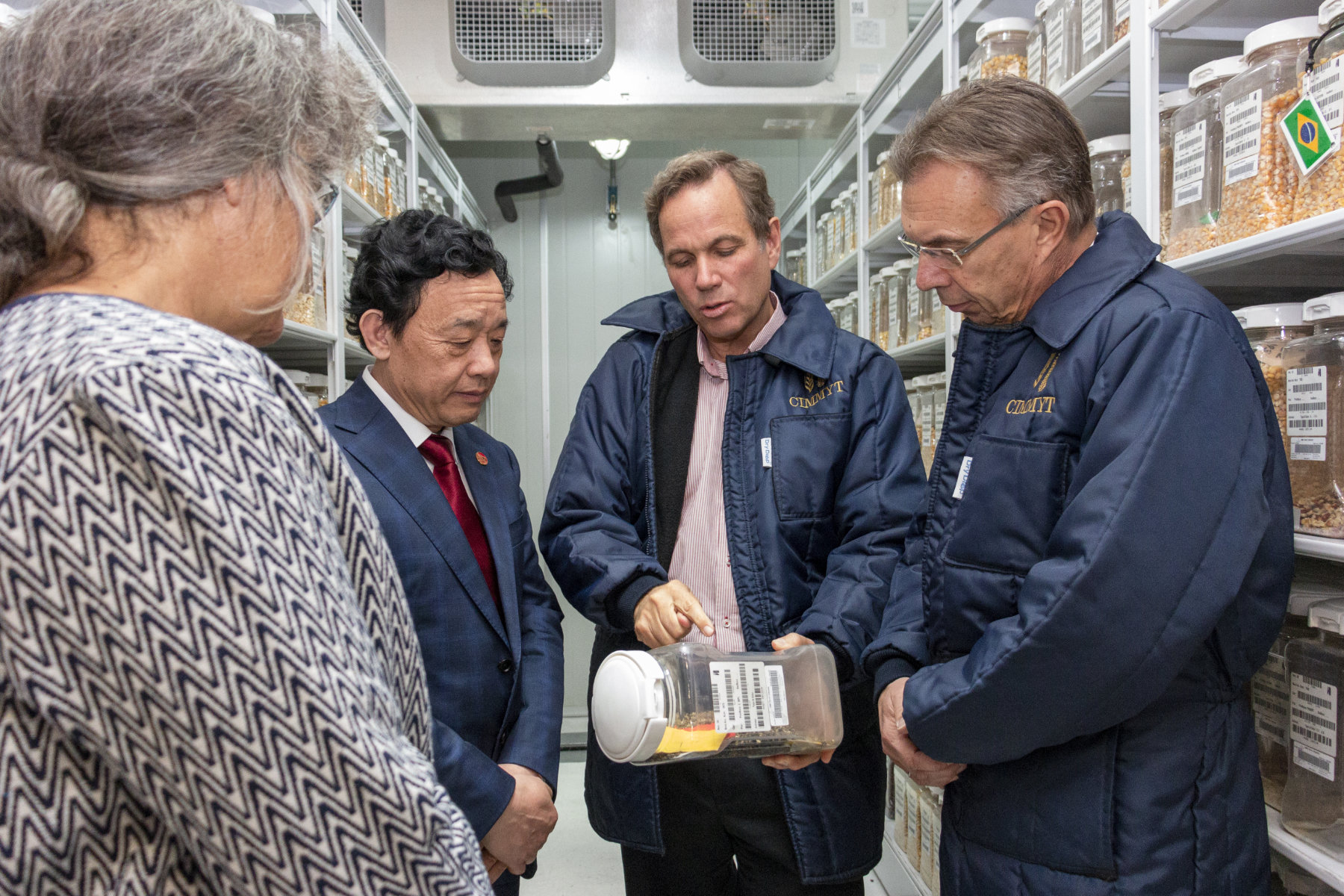
During the visit, Qu was also introduced to CIMMYT’s small-scale machinery, which is used around the world to sustainably intensify production. CIMMYT often sources machines, such as seed planters and harvesters, from China to provide effective and efficient solutions that add tangible value for smallholders at an appropriate price point.
Bringing together advanced technology and inexpensive tools, CIMMYT pioneered the GreenSeeker, a handheld tool to advise farmers on the appropriate amount of nitrogen fertilizer to add to their crops. This tool gives farmers the double benefit of increased profitability and reduced negative environmental impacts. The director of CIMMYT’s Sustainable Intensification program, Bruno Gérard, showed a machine-mountable version of this tool, which could connect to a two-wheel tractor and automatically add the appropriate amount of fertilizer.
Gérard also explained CIMMYT’s efforts to develop mechanization as a service, pointing to the manual on developing mechanization service providers, jointly developed by CIMMYT and FAO: “Mechanization has the potential to improve environmental sustainability, farm productivity and reduce labor drudgery. If mechanization is to be adopted at scale and sustainably, in most cases it has to be provided through service provision to smallholder farmers.”
At the end of the visit, to underline the shared commitment to collaboration that began in the 1970s, Kropff and Qu signed a memorandum of understanding for the establishment of a China-CIMMYT joint laboratory for maize and wheat improvement.
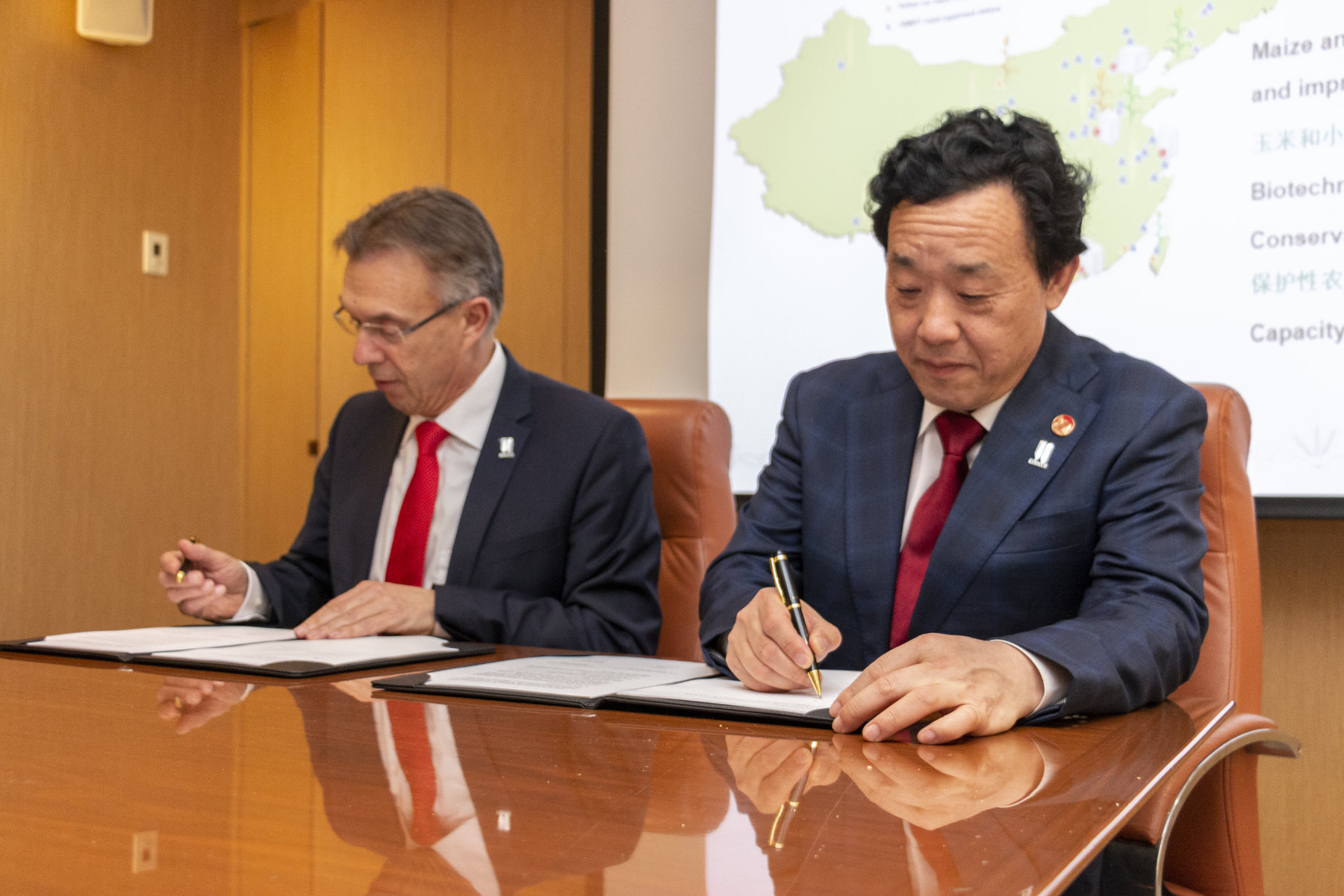

The Ethiopian wheat sector has seen progress since the early 2000s, more than doubling the average farm yields from 1.13 tons per hectare in 1998/99 to 2.74 tons per hectare in 2017/18. Progressive farmers who plant improved wheat varieties and follow recommended agronomic practices could harvest four to six tons per hectare in high-potential wheat growing areas. However, the production is not keeping up with the growing wheat demand: imports reached over 1.5 million tons last year. The Ethiopian government has announced recently that the country should become wheat self-sufficient over the next four years.
One of the biggest wheat production challenges in Ethiopia has been the stem rust and yellow rust diseases caused by Pucccinia spp, which severely affected popular wheat varieties like Kubsa, Galema and Digalu that wiped out from production.
In response to these losses, the International Maize and Wheat Improvement Center (CIMMYT) started an emergency project to multiply and disseminate rust-resistant wheat varieties in the affected regions in 2014, with support from USAID.
The following year, CIMMYT launched the Seed Multiplication and Delivery of High Yielding Rust Resistant Bread and Durum Wheat Varieties to Ethiopian Farmers project. It benefitted people in 54 woredas (districts) of 4 regions: Amhara, Oromia, SNNP and Tigray. CIMMYT collaborated with the Ethiopian Institute of Agricultural Research (EIAR), regional agricultural research institutes and the regional bureaus of agriculture.
This wheat seed scaling project wrapped up with a closure workshop on March 7, 2019. Organized by CIMMYT and EIAR, it gathered representatives from USAID, policymakers, researchers and other governmental and non-governmental institutions.
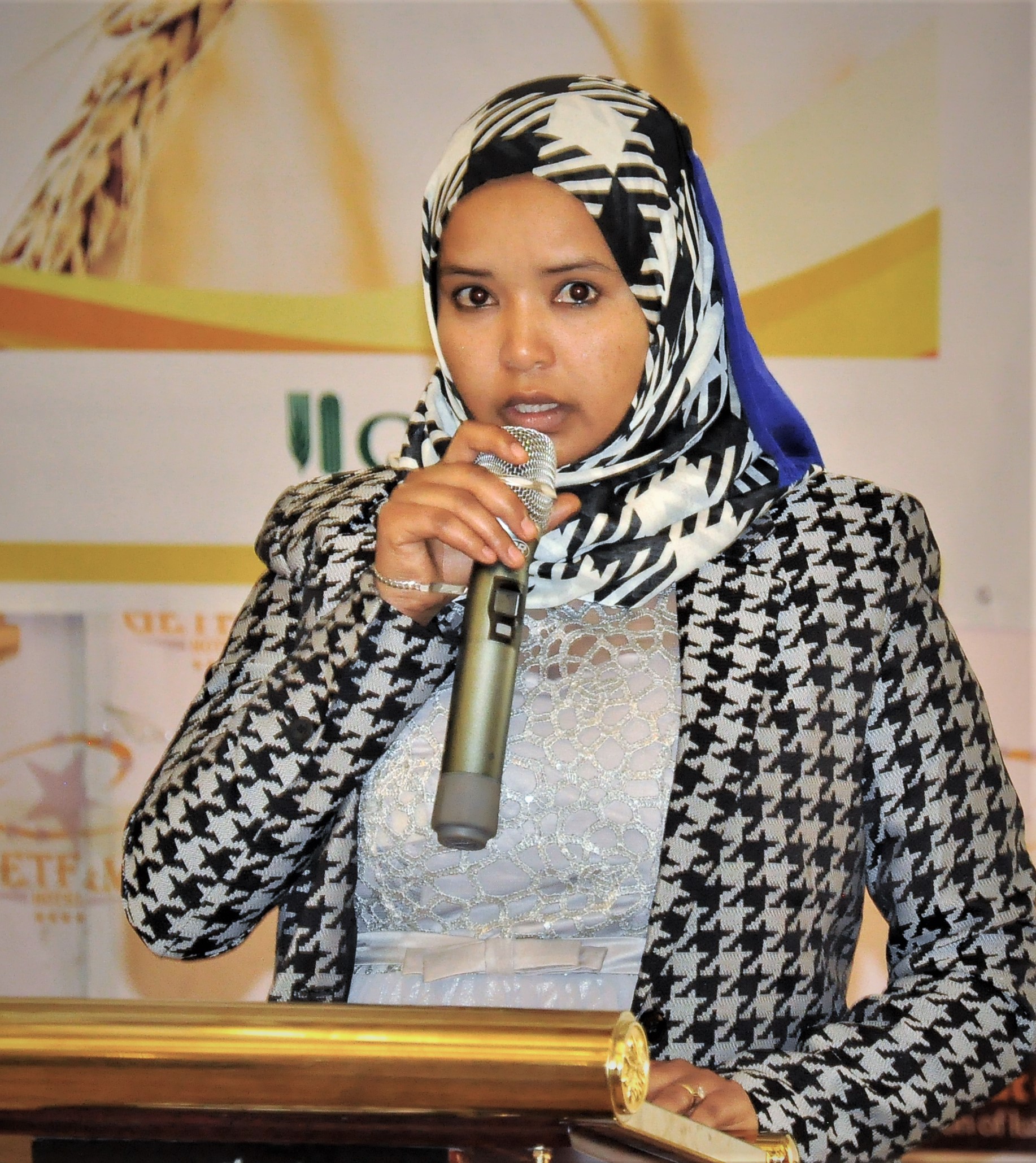
State minister of agriculture Aynalem Nigussie noted that the project boosted farmers’ productivity thanks to better seeds, improved farming practices and increased knowledge to deal with wheat rust diseases. She recognized that the project aligned with national priorities, as the government is devising a new seed policy to address the current challenges of the Ethiopian wheat seed sector.
CIMMYT’s representative in Ethiopia, Bekele Abeyo, highlighted some of the project outcomes. Some of the achievements in the past four years included the release and demonstration of 23 wheat varieties — 18 bread and 5 durum types —, increased access to these improved seeds for 131,132 households and production of 39,750 tons of wheat grain. Extension agents from 54 woredas participated in training in wheat rust management, recommended agronomic packages for the new wheat varieties, and field data collection and management.
Lessons learned
Abeyo explained that the project could reach a high number of farmers thanks to effective teamwork between the various stakeholders, seed support on revolving bases and a decentralized seed production to reach even remote places. Clustering farmers’ plots favored quality seed production.
Participants flagged weak market linkages, particularly for farmers producing durum wheat, , as a bottleneck to address. Workshop participants recommended the establishment of a wheat task force involving the private sector and with continuous support from funders like USAID.
The director general of EIAR, Mandefro Nigusse, said that the issues raised are inputs for further actions, and some will have to be directed to researchers and breeders to come up with additional solutions for the challenges the wheat sector is facing.
Eyasu Abrha, Advisor to the Minister of Agriculture, officially closed the workshop. He noted that the government of Ethiopia is putting effort into ensuring nutritional and food security, and that projects such as this one are important to address critical challenges in the sector. Abrha acknowledged the support of CIMMYT, EIAR and USAID, and called for a continued collaboration with the government of Ethiopia to meet nutritional and food security goals.
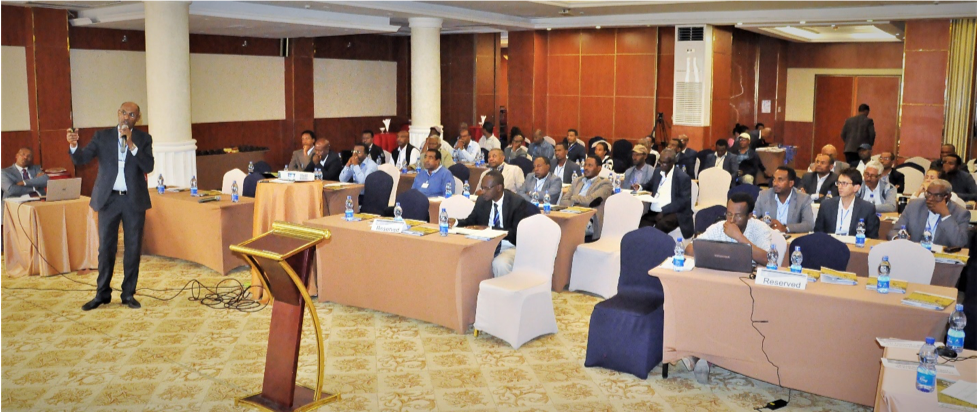
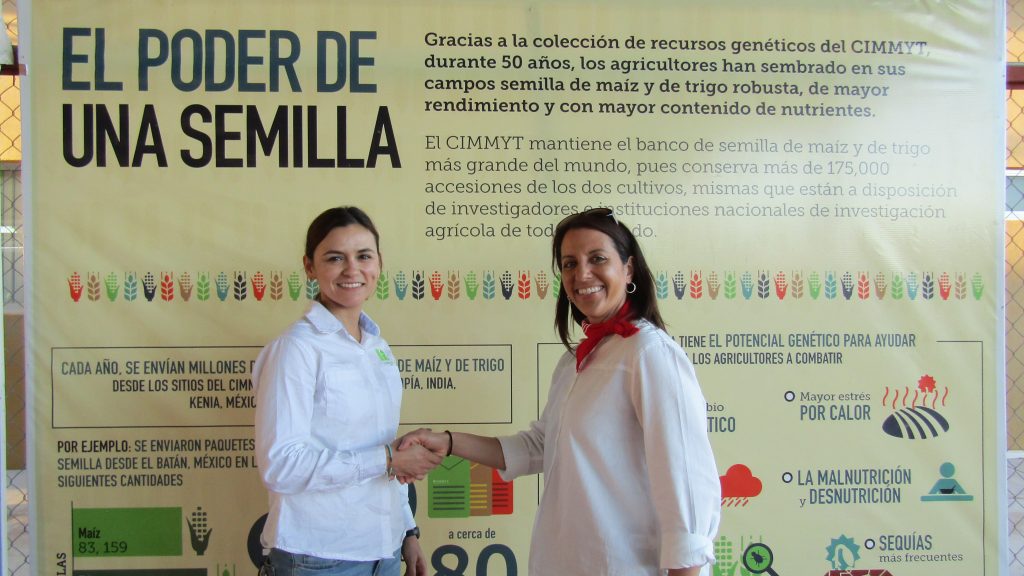
As a native of Obregon, Mexico, Carolina Rivera has a unique connection to the heart of Norman Borlaug’s wheat fields. She is now carrying on Borlaug’s legacy and working with wheat as a wheat physiologist at the International Maize and Wheat Improvement Center (CIMMYT) and data coordinator with the International Wheat Yield Partnership (IWYP).
Given her talents and passion for wheat research, it is no surprise that Rivera is one of the six recipients of the 2019 Jeanie Borlaug Laube Women in Triticum (WIT) Early Career Award. As a young scientist at CIMMYT, she has already worked to identify new traits associated with the optimization of plant morphology aiming to boost grain number and yield.
The Jeanie Borlaug Laube WIT Award provides professional development opportunities for women working in wheat. The review panel responsible for the selection of the candidates at the Borlaug Global Rust Initiative (BGRI), was impressed by her commitment towards wheat research on an international level and her potential to mentor future women scientists.
Established in 2010, the award is named after Jeanie Borlaug Laube, wheat science advocate and mentor, and daughter of Nobel Laureate Dr. Norman E. Borlaug. As a winner, Rivera is invited to attend a training course at CIMMYT in Obregon, Mexico, in spring 2020 as well as the BGRI 2020 Technical Workshop, to be held in the UK in June 2020. Since the award’s founding, there are now 50 WIT award winners.
The 2019 winners were announced on March 20 during CIMMYT’s Global Wheat Program Visitors’ Week in Obregon.
In the following interview, Rivera shares her thoughts about the relevance of the award and her career as a woman in wheat science.
Q: What does receiving the Jeanie Borlaug Laube WIT Award mean to you?
I feel very honored that I was considered for the WIT award, especially after having read the inspiring biographies of former WIT awardees. Receiving this award has encouraged me even more to continue doing what I love while standing strong as a woman in science.
It will is a great honor to receive the award named for Jeanie Borlaug, who is a very active advocate for wheat research. I am also very excited to attend the BGRI Technical Workshop next year, where lead breeders and scientists will update the global wheat community on wheat rust research. I expect to see a good amount of women at the meeting!
Q: When did you first become interested in agriculture?
My first real encounter with agriculture was in 2009 when I joined CIMMYT Obregon as an undergraduate student intern. I am originally from Obregon, so I remember knowing about the presence of CIMMYT, Campo Experimental Norman E. Borlaug (CENEB) and Instituto Nacional de Investigación Forestales Agrícolas y Pecuario (Inifap) in my city but not really understanding the real importance and impact of the research coming from those institutions. After a few months working at CIMMYT, I became very engrossed in my work and visualized myself as a wheat scientist.
Q: Why is it important to you that there is a strong community of women in agriculture?
We know women play a very important role in agriculture in rural communities, but in most cases they do not get the same rights and recognition as men. Therefore, policies — such as land rights — need to be changed and both women and men need to be educated in gender equity. I think the latter factor is more likely to strengthen communities of women, both new and existing, working in agriculture.
In addition, women should participate more in science to show that agricultural research is an area where various ideas and perspectives are necessary. To achieve this in the long run, policies need to look at current social and cultural practices holding back the advancement of women in their careers.
Q: What are you currently working on with CIMMYT and IWYP?
I am a post-doctoral fellow in CIMMYT’s Global Wheat Program where I assist in collaborative projects to improve wheat yield potential funded by IWYP. I am also leading the implementation of IWYP’s international research database, helping to develop CIMMYT’s wheat databases in collaboration with the center’s Genetic Resources Program. Apart from research and data management, I am passionate about offering trainings to students and visitors on field phenotyping approaches.
Q: Where do you see yourself in the agriculture world in 10 years?
In 10 years, I see myself as an independent scientist, generating ideas that contribute to delivering wheat varieties with higher yield potential and better tolerance to heat and drought stresses. I also see myself establishing strategies to streamline capacity building for graduate students in Mexico. At that point, I would also like to be contributing to policy changes in education and funding for science in Mexico.
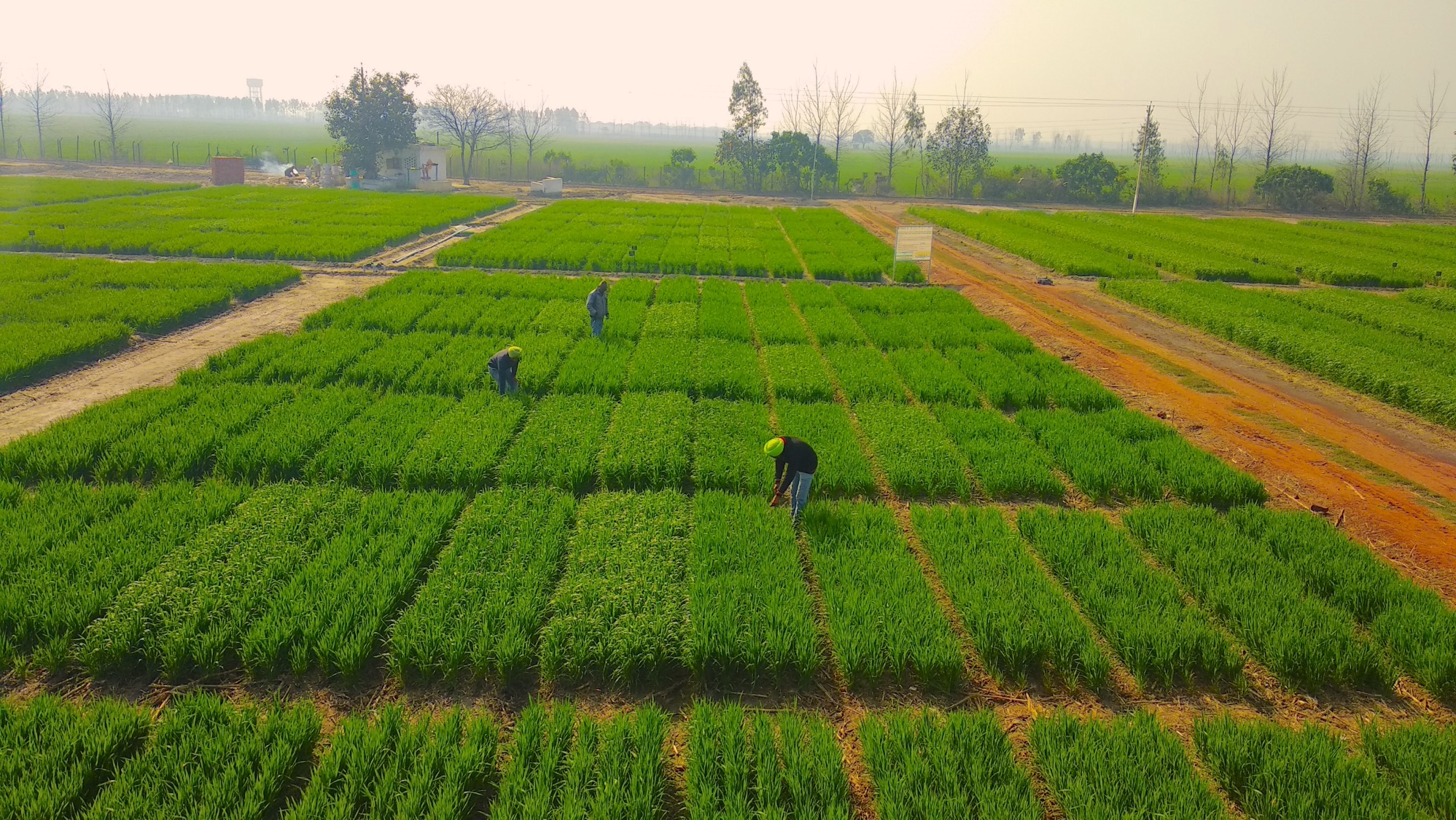
On World Water day, researchers show how India’s farmers can beat water shortages and grow rice and wheat with 40 percent less water
India’s northwest region is the most important production area for two staple cereals: rice and wheat. But a growing population and demand for food, inefficient flood-based irrigation, and climate change are putting enormous stress on the region’s groundwater supplies. Science has now confronted this challenge: a “breakthrough” study demonstrates how rice and wheat can be grown using 40 percent less water, through an innovative combination of existing irrigation and cropping techniques. The study’s authors, from the International Maize and Wheat Improvement Center (CIMMYT), the Borlaug Institute for South Asia (BISA), Punjab Agricultural University and Thapar University, claim farmers can grow similar or better yields than conventional growing methods, and still make a profit.
The researchers tested a range of existing solutions to determine the optimal mix of approaches that will help farmers save water and money. They found that rice and wheat grown using a “sub-surface drip fertigation system” combined with conservation agriculture approaches used at least 40 percent less water and needed 20 percent less Nitrogen-based fertilizer, for the same amount of yields under flood irrigation, and still be cost-effective for farmers. Sub-surface drip fertigation systems involve belowground pipes that deliver precise doses of water and fertilizer directly to the plant’s root zone, avoiding evaporation from the soil. The proposed system can work for both rice and wheat crops without the need to adjust pipes between rotations, saving money and labor. But a transition to more efficient approaches will require new policies and incentives, say the authors.
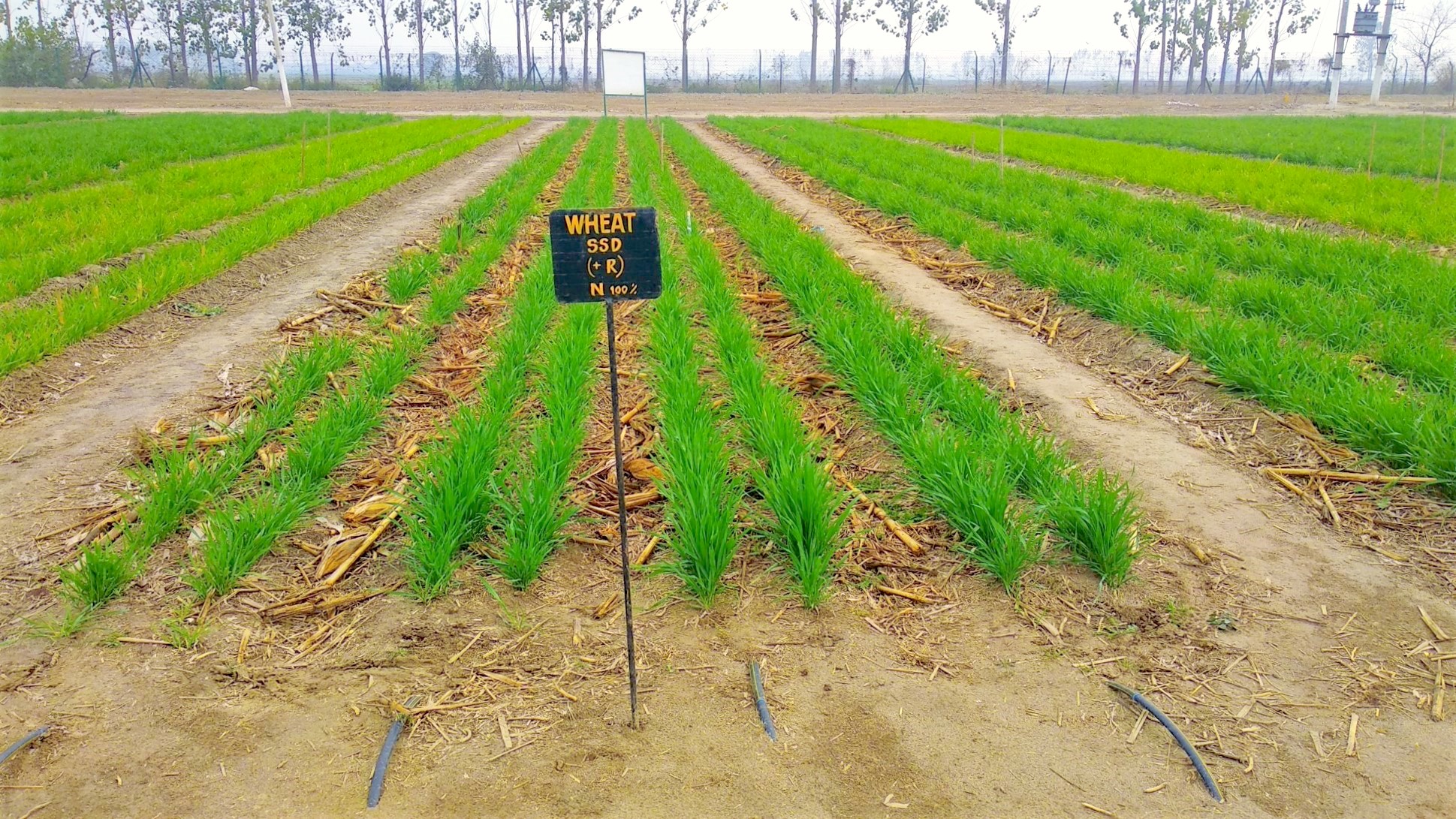
Read the full story:
Innovative irrigation system could future-proof India’s major cereals. Thomsom Reuters Foundation News, 20 March 2019.
Read the study:
Sidhu HS, Jat ML, Singh Y, Sidhu RK, Gupta N, Singh P, Singh P, Jat HS, Gerard B. 2019. Sub-surface drip fertigation with conservation agriculture in a rice-wheat system: A breakthrough for addressing water and nitrogen use efficiency. Agricultural Water Management. 216:1 (273-283). https://doi.org/10.1016/j.agwat.2019.02.019
The study received funding from the CGIAR Research Program on Wheat (WHEAT), the Indian Council of Agricultural Research (ICAR) and the Government of Punjab. The authors acknowledge the contributions of the field staff at BISA and CIMMYT based at Ludhiana, Punjab state.
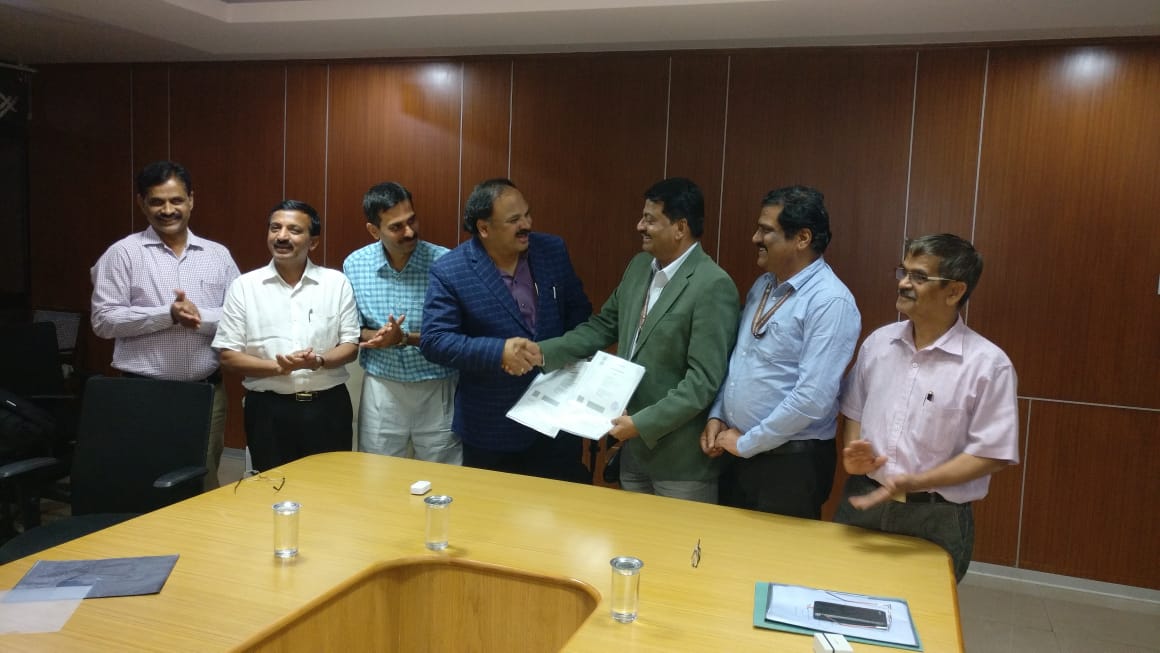
KARNAKATA, India (CIMMYT) — The International Maize and Wheat Improvement Center (CIMMYT) and the University of Agricultural Sciences-Bangalore (UAS-Bangalore) have signed a collaboration agreement for establishing a maize doubled haploid (DH) facility at the Agricultural Research Station in Kunigal (ARS-Kunigal), Tumkur district, Karnataka state, India.
CIMMYT will establish and operate the maize DH facility, including field activities and the associated laboratory. Occupying 12 acres of land, the facility is estimated to produce at least 30,000 DH lines a year. CIMMYT hopes the facility to be operational by the last quarter of 2019.
The maize DH facility, funded by the CGIAR Research Program on Maize (MAIZE), fulfills a very important requirement of the region. It has the potential to accelerate maize breeding and hybrid development and significantly increase genetic gains through maize breeding in Asia. During the 13th Asian Maize Conference in Ludhiana, India (October 8-10, 2018), several partners — including the Indian Institute of Maize Research (ICAR-IIMR) — emphasized the urgent need for a state-of-the-art maize DH facility that could serve breeding programs across Asia.
“This is indeed a major landmark for maize breeding, especially in the public sector, not only in India, but also in Asia,” said B.M. Prasanna, Director of CIMMYT’s Global Maize Program and the CGIAR Research Program on Maize (MAIZE). “The facility will provide maize DH development services, not only for the maize breeding programs of CIMMYT and UAS-B, but also for national agricultural research system institutions and small and medium-sized seed companies engaged in maize breeding and interested to pursue DH-based advanced maize breeding strategies in Asia. DH technology, in combination with molecular marker-assisted breeding, can significantly increase genetic gains in maize breeding.”
“The maize doubled haploid facility … will be the first of its kind in the public domain in Asia,” said S. Rajendra Prasad, Vice Chancellor of UAS-Bangalore. “The work done at this facility will certainly benefit the farmers of the state, country and the Asian region, by accelerating maize breeding and improving efficiencies.”
The signing of the collaboration agreement took place on February 18, 2019 at UAS-Bangalore’s campus in Bengaluru. CIMMYT was represented by B.M. Prasanna and BS Vivek, Senior Maize Breeder. UAS-Bangalore was represented by S. Rajendra Prasad; Mahabaleshwar Hegde, Registrar, and Y.G. Shadakshari, Director of Research.
The benefits of doubled haploid technology
DH maize lines are highly uniform, genetically pure and stable, and enable significant saving of time and resources in deriving parental lines, which are building blocks of improved maize hybrids.
Over the last 12 years, CIMMYT has worked intensively on optimizing DH technology for the tropics. Researchers released first-generation tropicalized haploid inducers in 2012, and second-generation tropicalized haploid inducers in 2017, in partnership with the University of Hohenheim, Germany. In 2017, CIMMYT developed more than 93,000 maize DH lines from 455 populations, and delivered them to maize breeders in Africa, Asia and Latin America.
INTERVIEW OPPORTUNITIES:
B.M. Prasanna – Director of CIMMYT’s Global Maize Program and the CGIAR Research Program on Maize (MAIZE).
FOR MORE INFORMATION, CONTACT THE MEDIA TEAM:
Jennifer Johnson – Maize Communication Officer, CIMMYT. J.A.JOHNSON@cgiar.org, +52 (55) 5804 2004 ext. 1036.